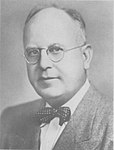1950 Pennsylvania gubernatorial election
| ||||||||||||||||||||
| ||||||||||||||||||||
 County results Fine: 40-50% 50-60% 60-70% 70-80% Dilworth: 50–60% 60–70% | ||||||||||||||||||||
| ||||||||||||||||||||
| Elections in Pennsylvania |
|---|
 |
|
|
The 1950 Pennsylvania gubernatorial election was held on November 7. For the twenty-second time in twenty-five elections, the Republican candidate was victorious, but by a much smaller than usual margin. Superior Court Judge John S. Fine defeated Democrat Richardson Dilworth, the City Controller of Philadelphia. This election marked the last time until 2022 that a political party would win three consecutive gubernatorial elections in Pennsylvania.
Major Party Candidates
Democratic
- Richardson Dilworth, Philadelphia City Controller
- running mate: Michael Musmanno, Court of Common Pleas Judge (from Allegheny County)
Republican
- John Fine, Superior Court Judge (from Luzerne County)
- running mate: Lloyd Wood, State Senator (from Montgomery County)
Campaign
Despite the popularity of outgoing governor (and 1950 U.S. Senate candidate) Jim Duff and the low approval ratings of President Harry Truman, Democrats came into the election with a cautiously optimistic outlook. In Dilworth, they had selected a charismatic candidate with a strong reputation as a reformer after serving as a key figure in the Democratic overthrow of Philadelphia's corrupt Republican political machine. Furthermore, although Republicans held registration advantages throughout the state, many voters were ambivalent toward their policies due to a 1949–50 recession that impacted crucial heavy industries.[1]
In contrast to the energetic Dilworth, the Republican nominee Fine was somewhat uncomfortable in the public eye, after having spent his career as a backroom power player and party boss. Fine had once been a close associate of progressive Governor Gifford Pinchot and had spent the previous twenty years as Northeastern Pennsylvania 's key political figure. Fine represented the consistency of the long-dominant state political machine and, although he was somewhat more conservative than the outgoing governor, was chosen as Duff's hand-picked successor to hold steady a Republican ship that was on cruise control.[2]
The election was marked by a variety of brutal personal attacks. First, Fine was forced to wage a contentious primary battle. Jay Cooke, a wealthy Philadelphia banker, mobilized the arch-conservative business wing of the party, while Charles Williams, a Lycoming County Common Pleas Judge, led a small but vocal group of anti-machine Republicans. Although Fine won by twenty points over Cooke, the party had difficulty healing their wounds in the general election. In the fall, Fine and Dilworth further toned up the rhetoric. The Philadelphia Democrat portrayed his opponent as a crony who oversaw a Tammany Hall-style patronage system and asserted that Fine's agenda would "roll back the Twentieth Century." Fine fired back by painting Dilworth as a candidate who would be soft on communism and allow subversives to penetrate state government; he even went so far as to compare state Democrats to a "psychiatric problem." [1]
On Election Day, Fine carried the gubernatorial ticket by about two points, despite Governor Duff's large win in the Senate race. Although Fine ran well in heavily Republican Central Pennsylvania and limited Dilworth's advantage in the Democratic stronghold of metropolitan Pittsburgh, he lost by a slim margin his home base in the Scranton/Wilkes-Barre area. Furthermore, Dilworth gained 42% of the vote in Philadelphia's four suburban counties, despite only 17% of area residents holding Democratic voter registration.[2]
Results
| Pennsylvania gubernatorial election, 1950[3][4] | |||||
|---|---|---|---|---|---|
| Party | Candidate | Running mate | Votes | Percentage | |
| Republican | John Fine | Lloyd Wood | 1,796,119 | 50.7% | |
| Democratic | Richardson Dilworth | Michael Musmanno | 1,710,355 | 48.3% | |
| Prohibition | Richard Blews | 12,282 | .3% | ||
| G.I.'s Against Communism | Reggie Naugle | 7,715 | .2% | ||
| Progressive | Tom Fitzpatrick | 6,097 | .1% | ||
| Socialist | Robert Wilson | 5,005 | .1% | ||
| Independent | George Taylor | 1,645 | <.1% | ||
| Totals | 3,540,029 | 100.00% | |||
Notes
- ^ Kennedy, John J. (2006). Pennsylvania Elections: Statewide Contests from 1950-2004. ISBN 9780761832799.
- ^ Beers, Paul B. (November 2010). Pennsylvania Politics Today and Yesterday: The Tolerable Accommodation. ISBN 978-0271044989.
- ^ The Pennsylvania Manual, p. 728.
- ^ The Pennsylvania Manual, p. 727.
References
- Ackley, Gayle; Arcuri, Patricia D, eds. (1979). The Pennsylvania Manual. Vol. 104. Harrisburg: Pennsylvania Department of General Services.


